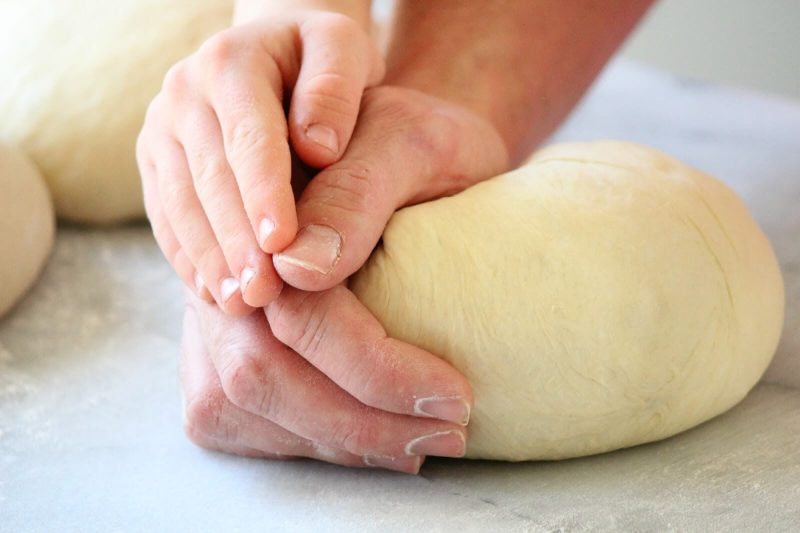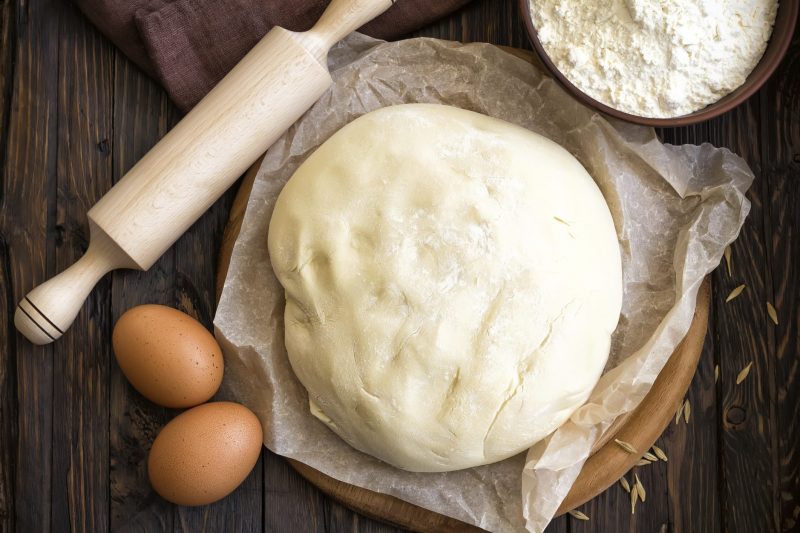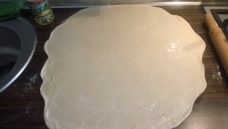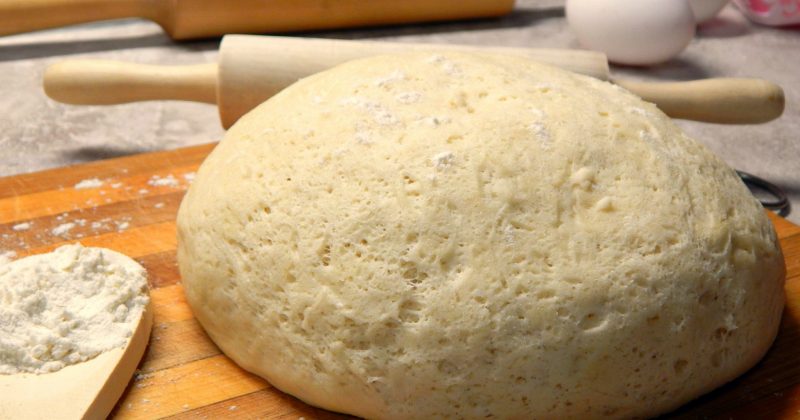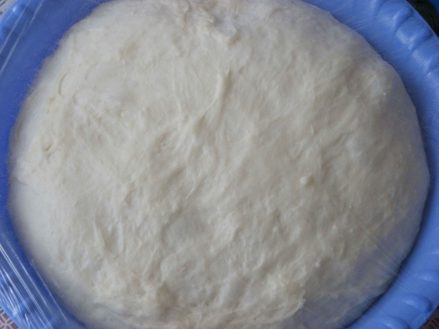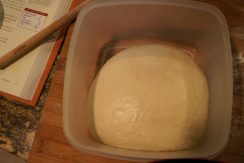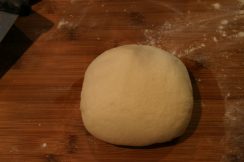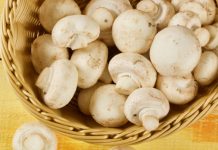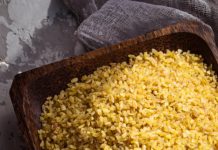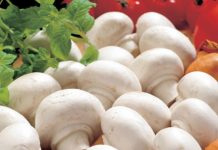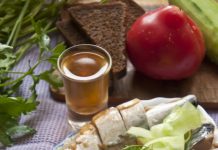What can spoil pies with a sweet or savory, but very tasty filling? Baking will not be tasty if the dough, having cooled after heat treatment, has turned into a dense and tasteless mass. But this will never happen with those housewives who use the proven dough “like fluff”. You can make it by taking kefir, milk, water or sour cream as a basis, using eggs and butter, or without these products. Below are the different yeast kneading options and the fast yeast-free option.
Material Content:
Classic dough “like fluff” on kefir
The classic version of this test is easily applicable for oven baking and fried pies.
Its moderately sweet taste makes it possible to use absolutely all types of sweet and savory fillings.
Buns will also turn out to be tasty if steaming raisins or other dried fruits are introduced into the flour mixture during kneading.
Proportions of required products:
- 250 ml of kefir;
- 11 g quick-acting in powder or 30 g pressed fresh yeast;
- 95 ml of sunflower or olive oil;
- 25 g of sugar;
- 4.5 g of salt;
- 540 g of flour.
Knead in steps:
- Kefir should be sent to the microwave or to the stove so that its temperature rises to 35 - 37 ° С. Dilute salt, sugar and yeast in it. Add two or three tablespoons of flour to the resulting solution, whisk all the lumps with a whisk and send to heat for 10 minutes for dry yeast and for 20 minutes for alcohol.
- Pour a little warmed oil into the dough that has risen with a foamy head and, without pouring all at once, stir in the flour. The result of all the manipulations will be a soft, not clogged with flour, and a lump clinging to the palms a little.A significant step in the preparation of yeast dough is its kneading.If you do this with your hands, you need to “muss” at least 10-15 minutes, and a planetary mixer or a bread machine will cope with this task much faster.
- After this, it remains only to place the mass in heat, to allow it to grow in volume two times and it is possible to form products. When using dry fast-acting yeast, it takes about half an hour to rise. Those who lay fresh yeast will need to wait approximately one hour.
It should separately focus on choosing kefir for the test. The percentage of fat content of the product will in no way affect the splendor of baking or its taste, but the sour-milk base must always be fresh. Do not take seriously the advice of putting expired or sour kefir in the dough if your health is expensive.
For pies
Dough for pies is best prepared using yeast in a sparse way. This makes the baking process longer, but the splendor of the finished products more than justifies all the time costs.
For dough to prepare:
- 150 ml of water;
- 10 g of sugar;
- 30 g of fresh yeast.
The main batch includes:
- 300 ml of milk;
- 5 g of salt;
- 5 g of sugar (for sweet pastries, the amount of sweetener can be increased to 50 g);
- 1 egg
- 30 ml of vegetable oil;
- 600 - 650 g of flour.
The sequence of actions:
- Dissolve yeast and sugar in non-cold water. Allow this solution to stand in a warm kitchen and cover with a high cap of foam.
- Next, the dough should be mixed with all the components of the main batch, except flour. All products must be at room temperature, not from the refrigerator, so that the dough turns out to be lush and rise quickly.
- Flour is not poured all at once, but gradually, so as not to “clog” the dough with it. As soon as the mass ceases to stick to the hands, it can be sent to ripen in a warmer place. The rising mass will only have to be kneaded, divided into parts and immediately used for sculpting pies.
Soft and lush bun dough
This soft and magnificent fluffy dough is the perfect base for a variety of rolls, buns and rolls. For their filling, you can use a mixture of sugar and cinnamon, poppy or nut filling. But if you add raisins to the dough or just sprinkle the finished products with poppy seeds or sesame seeds, they, without filling fillings, will also come out very tasty.
List of required ingredients:
- 300 ml of milk;
- 100 g of sugar;
- 14 g instant high-speed yeast;
- 50 g butter;
- 15 ml of vegetable oil;
- 2.5 g of salt;
- 2 g of vanillin;
- 1 egg
- 550 - 600 g of flour.
Knead the dough as follows:
- Combine warm milk with sugar, salt, vegetable oil and yeast. Beat a raw egg, add flavored vanillin and further stir in the flour.
- When most of the flour is combined with the rest of the products, add a little soft butter and the rest of the flour.
- When the batch will occupy in the bowl the volume that is 2 times larger than the initial one, you should knead it and after 20 minutes start baking the softest buns in the world.
In order for the dough to fit well, he needs to provide the appropriate conditions. In summer, this is not difficult to do, and in the cold season you will have to resort to small tricks.
A bowl of dough can be placed in a larger capacity tank filled with hot water. You can place the dough in a preheated but turned off oven with the door ajar or place it near the battery.
Cooking in milk
Not always the presence of eggs and butter in the test guarantees a magnificent and airy result.
There is a more economical version of the base on milk, but without these products, according to which even the novice housewives get the very dough “like fluff”:
- 200 ml of milk;
- 40-50 g of sugar;
- 60 ml of vegetable oil;
- 1.5 g of salt;
- 10 g pressed yeast;
- 450 - 470 g of flour.
How to knead:
- Pour sugar, salt into warm milk and pour vegetable oil. Next, pick up a whisk and shake the mass until smooth.
- Mix flour in small portions.First, knead the mass with a spatula, and when it is sufficiently thickened, put it on a table sprinkled with flour and mix it well with your hands, dusting the surface with flour.
- Put the dough collected in the kolobok into a greased bowl, cover with a towel and send to a warm place for ripening. When it “grows up” well, it should be slightly crushed and left to warm for another 40 minutes.
Butter yeast dough “like fluff”
This version of the “down” test is prepared using yeast in powder, therefore the technology of mixing it is somewhat different from the traditional recipe. This dough is suitable for pies, rolls, pies and the Dagestan miracle.
To knead it you will need:
- 150 ml of milk;
- 150 ml of water;
- 50 g of melted butter;
- 1 egg
- 700 g flour;
- 5 g of dry yeast;
- 20 g of sugar;
- 10 g of salt.
Cooking Technology:
- Sift the flour into a large bowl, send salt, yeast and sugar to it. We carefully stir everything with a whisk and make a deepening in the resulting loose mixture.
- Shake the egg until smooth, combine it with melted butter, water and milk. Pour the resulting mixture into a depression in the flour and, pouring the flour mixture from the edges to the center, knead the dough.
- The resulting mass, slightly sticky to the hands, should be kept warm for one and a half to two hours. The dough is ready!
Based on cottage cheese
Cottage cheese-based pastries are very porous, with holes not inferior to the holes in the Maasdam cheese. You can use this dough for pies, pies, rolls, bagels and rugs.
For one portion of cottage cheese kneading you will need:
- 250 g of cottage cheese;
- 135 ml of vegetable oil;
- 2 eggs;
- 100 g of sugar;
- 3 g of salt;
- 10 g of slaked soda;
- 300 g of flour.
Working process:
- Twist the dry cottage cheese through a meat grinder or squeeze through a sieve, and simply mash the soft curd with a fork.
- Then add eggs and vegetable oil to it. Grind these ingredients with a fork or mashed potato masher until smooth.
- Salt the resulting mass, add sugar and stir again until smooth.
- After, introduce slaked soda, and after it, stir in the flour. The dough should be very soft. Before forming products, he should be allowed to rest at room temperature for about 20 minutes.
Curd dough can absorb a different amount of flour, depending on the moisture content of the curd. The drier this product, the less it will be needed for kneading.
But with a wet, pasty product you need to be careful so as not to get carried away and not to overdo it with flour. In this case, the test "like fluff" is not worth dreaming.
Simple recipe on the water
During fasting, when the choice of foods for eating is not scarce, then limited, you can bake delicious cakes with potato or cabbage filling, using dough “like fluff” on water for them. If the filling for baking is made from boiled potatoes, then a decoction from it can be safely used for kneading. It will turn out even tastier.
The composition of the test:
- 500 ml of water;
- 100 ml odorless vegetable oil;
- 180 g of sugar;
- 50 g of yeast;
- 1000 g of flour.
Kneading Algorithm:
- In a refractory container, combine sugar, vegetable oil and 1/5 part of water. Boil the resulting mixture over a fire, and then add the rest with cold water. This will make the liquid temperature comfortable for yeast.
- Having dissolved the yeast in a sweet oil-water base, introduce a small amount of flour into it to get a dough by consistency, like low-fat sour cream. We send the batter half an hour away from noise and drafts into the heat.
- After the specified time, stir in the rest of the flour. Add the grain product exactly until the mass ceases to stick to the hands. By all means let the test ripen in warm conditions for about an hour (depending on the ambient temperature).
Grandma’s dough “like fluff” in a couple of minutes
It usually takes more than one hour to knead and ripen the yeast dough, but with this recipe for a quick grandmother’s dough, you can start making pies literally in two minutes. Can't believe it? Well, then, to check, you just need to take and bake something delicious from it.
Take:
- 150 g of kefir;
- 150 g sour cream;
- 25 g of sunflower oil;
- 3 g of salt;
- 1 egg
- 5 g of sugar;
- 10 g of baking powder;
- 400 - 450 g of flour.
Kneading Procedure:
- Beat the egg with a whisk until a smooth flowing consistency with grains of salt and sugar. Combine sour cream with kefir and egg mixture.
- Mix the flour crushed with the baking powder with liquid components.
- Then add oil and knead the dough carefully. Knead to stop as soon as it becomes a single lump, easily departing from the hands.
Of course, it is better to give this test some time to lie down and rest, but immediately after mixing it is clear that the baking will turn out to be soft and airy.


